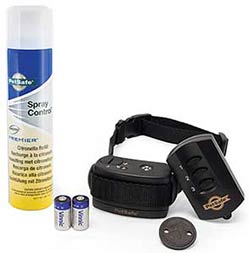Which Type of Training Collar is Best for My Dog? The Pros & Cons
 Training collars can make training a your dog a quicker and easier task
Training collars can make training a your dog a quicker and easier task
We sought the advice of the PetStreetMall product specialists and we've drawn up the pros and cons of the different types of training collars to help you find the one that's perfect for your pooch.
The 4 Approaches to Training Collars - What are your Choices?
Training collars fall into four categories: static stimulation, vibration, spray and ultrasound (ultrasound is actually a handheld device, not a collar). Each shares the common goal of providing a sensory stimulation - scent, feel or sound - to get the dog's attention.
Static Collars.
The most popular of all training collars, static collars use adjustable levels of correction while training a dog.  The Dogtra IQ Plus has an impressive 400 yard range.
The Dogtra IQ Plus has an impressive 400 yard range.
The big misconception is that static correction collars give dogs an electric shock, which leads to the misnomer 'shock collar'. In reality the static is like the static pulse you sometimes feel when touching a TV screen.
For static training collars:
- Offers both static and tone only modes from one unit.
- Highly adjustable levels of sensitivity.
- Operates at various distances.
- Can be expanded to train multiple dogs.
- Very adaptable and versatile.
- Models available for all dog sizes
- Can be more expensive to purchase than other types of collar.
- Stigma of the (unwarranted) 'shock collar' nickname.
- Costs of replacing batteries in non-rechargeable models can add up.
 PetSafe's VT-1 vibration collar in action Vibration Collars
PetSafe's VT-1 vibration collar in action Vibration Collars
Vibration collars rely on adjustable levels of vibration to assist dog training. Capable of adjustable stimulation levels (vibration collars often have static settings as well) and a decent range of operation make vibration collars almost as versatile as static collars.
For vibration collars:
- Excellent alternative for those who don't like static collars.
- Good adjustability of correction levels.
- Expandable to train multiple dogs.
- Usable in a range of distances and weather conditions.
- More costly than spray collars or ultrasound trainers.
- May not fit very small or very large dogs.
 The PetSafe Spray Commander is completely harmless Spray Collars
The PetSafe Spray Commander is completely harmless Spray Collars
Targeting a dog's keenest sense - smell - the spray collar emits a misty spray (often scented with citronella or lemon) near the dog's snout to deter bad behavior. Acknowledged as harmless to pets, people and the environment, the spray collar is a very humane way of providing correctional stimulation.
For spray collars:
- Spray is harmless and humane.
- Some models come with additional tone only option.
- May be used as an effective bark collar.
- Cheaper than most static correction and vibration collars.
- Refilling the spray can become costly if dog continues to bark.
- Dog may become used to the spray, reducing its effectiveness.
 The K-II Enterprises Dazer II is compact and easy to use Ultrasound Trainers
The K-II Enterprises Dazer II is compact and easy to use Ultrasound Trainers
Emits a high-pitched ultrasonic tone only audible to dogs. Although discomforting to dogs the sound is not harmful to them and cannot be heard by humans. The simple handheld unit is very versatile when used to deter numerous bad behavioral habits. Can also be used to fend off unwanted attention from other dogs.
For ultrasound trainers:
- Versatile as deterrent against jumping, digging, going into trash, barking, etc.
- Doesn't require dog to wear an uncomfortable collar.
- Most inexpensive training option.
- Training success rate not as high as with the other collar options.
- Limited range of effectiveness.
Well there you have it; four different ways to assist you teach and train your dog, each with its unique set of pros and cons. Whatever product you ultimately decide upon, remember to keep the training process fun for your canine buddy and yourself.
By John Bone
